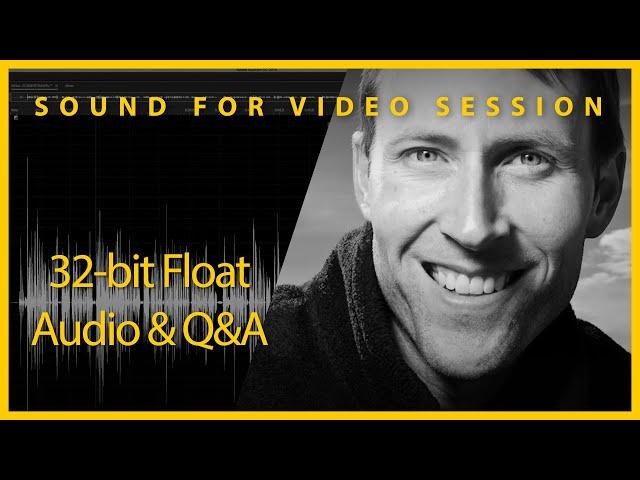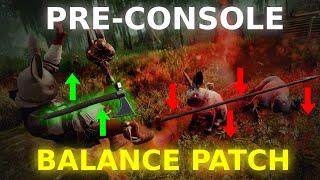
Sound for Video Session: 32-bit Float Audio & Q&A
Комментарии:

I think Curtis sometimes needs a dynamic range boost, a bit wider amplitude, reduce that compression =) Jokes aside, good explanation although a bit approximate in the comparisons to other formats in technical terms, 32bit float does not fully explain the implementation type, or dynamic range chosen per se. you could sample a terribly narrow dynamic range with 32bit float and a hugely wide one with 8bit if you wanted to, you'd have ridiculously high resolution on the 32bit and ridiculously low on the 8bit in those cases.
Ответить
Hi Curtis, quick Q if you have time to respond. I have the Zoom F3. Currently I am recording via a Pencil Condenser mic, and my Sony Alpha camera for doing my talking head videos. I then import the 32 bit float WAV file from the Zoom into Davinci, along with the Video file from the Camera. I sync them, then turn down the Camera audio. Now, I have just discovered the Zoom F3 can act as an Audio Interface. Do you know, if this is setup this way, if I set up Davinci to recognise the Zoom as the Audio Interface, and I go into Fairlight and click record whilst recording with the Camera at the same time, then do the same sync etc .. would I be recording through the Zoom in 32 bit float? or would I need to setup the Davinci Fairlight to record in 32 bit float .. and therefore I am kind of missing the point of having the Zoom in this setup?! I hope you see what I am getting at .. I already have an Apollo Twin, so I could always just use that and record in DR in 32 bit float I assume, so I am starting to wonder if there was any point in buying the Zoom apart from the fact it's designed to be out in the field, thus the name! :) I am looking to streamline the process, as there's no point in recording to the Zoom, importing the WAV etc, if I can just do this directly in Davinci.
Ответить
I bet our analog stages are not going to get more than 200 of range. this has to do with physics. I typically see a max of 160. Anything greater than that cannot have wires/connectors/buttons/switches. Most equipment has 120 of range without noise floor. Lesser equipment has the noise floor between -60 and -90.
No dual converters or trickery is going to get around this. This is physical phenomena. At that level of quietness the wires on the circuit board and the capacitors themselves become microphones. Resistors become SUPER noisy. The leads coming off the IC's are sources of noise. The ceramic case that the IC is housed in would have to be different... In my experience, currently we are capable of about 200db of range in the analog domain and near the bottom you can hear strange things, like static electricity. The TV power supply from 6 feet away. the fridge in another room is loud. your footsteps are godzilla and they break your eardrums. etc etc ... With all the power supplies in our modern world, using a dynamic mic at that level is silly caz there is SOO much electrical interference.

Hi Curtis, thank you for the detailed information! I am very new to using 32-bit float. I recently performed a test with a Rode VideoMic NTG and the Zoom F2. I had the F2 set to 48kHz / 32 bit Float (using the latest firmware version). I may have made a mistake by leaving the gain on the Rode VideoMic NTG fairly high while recording music close to the single speaker on the stage. Not all of the recording is clipped but the louder vocals are (just two people on stage with guitars and one singer at an outdoor famers market). I think I had the gain set high because I was also performing another test just sending the NTG audio to my camera (with the in-camera audio gain set to the lowest setting). So, my question is this. If I accidentally left the gain setting on the NTG fairly hot, would this be a problem when placing the mic fairly close to a loud stage speaker. There is audible clipping and also visible clipping in the waveform in Resolve even after lowering the gain. I don't know much about Resolve Fairlight so I'm hoping there is a way to recover this. Resolve does not indicate that the file is 32 bit float. I only see 48kHz Linear PCM in the file properties in Resolve. Audacity lists the file as 32 bit float but the clipping remains in Audacity as well when I reduce gain. (I have never used Audacity before today). Perhaps I have to keep my gain settings on the NTG on the lowest setting in potentially loud environments? I was not monitoring the audio because it was an impromptu test. I just thought I had a new magical 32-bit float device that could capture anything without clipping! Perhaps I am doing something wrong in Resolve - or perhaps I simply exceeded the capability of the signal at the mic itself by exposing it to a loud speaker while having the gain on the NTG too high. Thank you for all of your help! Chris
Ответить
❤️
Ответить
I was trying to decide between 3 portable options for recording interviews. I currently have a Zoom H6 that I love but want to add an even more portable option with 32 bit float. I was considering replacing my Zoom F1 with the Zoom F3 or Rode Wireless Go ii. I was suspicious of the Rode Wireless Go ii 32 bit float claims but thought IF anyone knows for sure its Curtis Judd. A quick search brought me to this video. 🙏🏼 Do you think the Zoom F3 would be a worthy upgrade to the Zoom F1 and to use with a lav — any recommendations? I work alone and appreciate a safety net. 🤗Looooooove your channel.
Ответить
I use Cubase 12 for music recording, it's a 32-bit float software. I tried to record with those settings and it didn't worked as you explained in your multiple videos. A bit later I realized that it's probably my old audio interface Steinberg UR44 that can't do it even if the software can, yes I'm a newbie :)
Ответить
This is such a helpful video! Transitioning from photo into video for casual home talking-head and outdoor fun-filming, I have assembled a kit so far of an a7iv to be rig-mtd, a Rode VideoMic GO II (wired), a Deity V.Lav (wired), and a Zoom H1n. All brand new. Yes, most of the budget went into the camera. 😁 I was just about to buy a $189 Beachtek DXA-MICRO-PRO PLUS Active Audio Adapter Mixer to get both Mics connected and have a bkup recording for safety. Now the F3 is available and, for another $150, I can be less concerned about gain adjustments in real-time— seems worth it. And FYI I'm learning Davinci Resolve. I listened to your entire (excellent!) video here and learned a lot but I'm still unsure of all the caveats. But I read this at B&H: "...or use the F3 as a 2x2 USB audio interface capable of 24-bit / 96 kHz resolution. USB audio interface functionality will be supported by a firmware update scheduled to be released in March 2022." Does that mean I can be on-the-go and switch the F3 from 32-bit to 24-bit recording as I desire? Or does it mean only when connected to my PC? It seems like being switchable between the two bit-depths answers all the considerations in your video.
⁉EDIT: uh-oh. Just saw your F3 video with this in the comments, only I don't know what it means. "As an audio interface you can record in 24-bit, but not on the F3 itself." Maybe it means I can record in the F3 only at 32-bit AND, if also connected to my a7iv for simultaneous recording, I can tell the a7iv to adjust the input signal and record it in 24-bit? Wow, the more I learn, the less I know.

16bit - capture your babies first words. 24bit capture a jet taking off. 32bit float - capture the big bang but you need a better pre-amp.
Ответить
Is there a video or resource showing a beginner how to use RX9 to process 32-bit float audio to get the best results? In this video you briefly noted "asymmetry" in the wave form when you pulled the gain down in the first clipped sample. I'd love to see other real-world examples of using RX9 on 32-bit float audio to solve common problems and get an export-worthy result. :)
Ответить
** Question: Hello, thank you for the video. Very helpful. I do a lot of live streams, weddings mainly. Much of the time I am live streaming the ceremony and recording internally. I will deliver a mastered copy of the ceremony with all the bells and whistles. It's multi camera and multi microphone. Generally, I use the XSWD system and record into the 48k 24 bit XLR inputs directly on my camcorder. When I need more than two inputs, I use the H6 to record that audio and send the mix out to my camcorder using the line out and a 1/8" to L/R XLR. SInce I'm live streamning I have to have my levels set properly in the first place. BUT...
If I used the XSWD (an ATPx Live digital transmission) would I see any benefit in recording in 32 bit float? I'm thinking no because the XSWD system is 24 bit.. and that would be the bottleneck. BUt Then I think about a UHF system and wonder if that would work better, for example the Comica BoomX-U. I believe it's digital too because the specifications have the latency at less than 20ms. That to me meands it's probably digital.
If none of this works, then would the only benefit of 32bit float come from a physical connection between the microphone and the recorder? Maybe someone can let me know if I'm on the right track with my thoughts. I would really like to use 32 bit float for the extra precaution of clipping in the event I need to recover something in post. Thanks!

Speaking of the signal chain, do you have any recommendations for a really high dynamic range microphone. Something recording loud location sound such as firearms, engines, etc without clipping the mic itself?
Ответить
Thanks for clarifying this. Seems like keeping my Zoom f4 and just utilizing the safety track is still a valid option vs purchasing the f3 which doesn't have as many input options. I do like the smaller size and it would be easier to mount to my filming rig. Maybe I'll sell my older H5 and get the f3.
Ответить
Fantastic presentation! Thank you so much for your fine work. It's a big help to all of us!
Ответить
Curtis,
From reading your replies, I understand you’ll be testing the Zoom F3. Please, if you can, test this:
1. A few popular condenser and dynamic mics: Rode NT1, Electro-Voice RE20, Sure SM7B, high-quality (low noise) lavalier mic, etc.
2. Audible noise on voice-over tests in treated room after at -6db and -3db (with compression and EQ).
3. If the unit (or available software) will allow, the noise level at -6db and -3db (with compression and EQ).
4. Adjusting the 32-bit float files to the correct levels on a Mac with non Adobe programs.
Thanks,
yYM

Useful stuff. The state of digital just keeps expanding, while the state of analog audio is pretty much where it's going to be. Just Gaussian noise in analog limits its dynamic range.
HDR Audio would be a good term, but not once the advertising copywriters get ahold of it.
I wonder if the AES might coin a term with a matching standard? Or, have they already?

Impressive. As always. Thank you.
Ответить
The specs on the new Zoom F3 seem not to mention its %THD figure...any thoughts about that?
Ответить
The very best information and well presented, thank you. First time on this channel !
Ответить
Not quite the scope of this video but perhaps you can cover Dante and in Dante Controller encoding at 32-bit? Would you have a lot more headroom for low signals for makeup gain after Dante gets to the subscribed receiver? (Quieter makeup gain than 24-bit Dante encoding)?
Ответить
Loved the comparison of how 32-bit float is implemented in Zoom F3 and MixPreII differences.
Ответить
As both a Behringer XR12 and XR18 user and live a event streamer it sounds like it was going balanced into stereo barring any other downstream issues this will give you a reverse phase on your right channel and if you're listening on mono it will cancel, if you're listening on stereo depending on your speaker separation you might not have an issue. and subsequently on headphones you will not hear the issue because your head is physically in the way and your brain can either perceive or not perceive the difference depending on factors. I think if I was in the moment I might not catch that but I have been able to tell in a testing setup environment. The simple solution is just go XLR to quarter inch and to a mono TS plug as the shield will connect to the "R" effectively making a unbalanced output on the mixer side. Either in Software or with a physical cable might need a custom-made you can then feed the same signal to left and right ( you can split but you cannot combine FYI see white paper: RaneNote Why not why ).
Also I like to have a device playing back the stream (like the age-old radio on in a radio station) so I can say I'm hearing the audio go all the way through the loop and back fine it must be an issue on their end and usually if somebody is complaining that they can't hear anything and I don't know why but they probably hit mute...... That could never happen And then they complain they paid so much money for this blah blah blah.

Sadly though PortaCapture X8 Can only Handle 112 dB Dynamic Range. Reply from Tascam Confirmed my suspicion
"Our engineering department has sent the following information...
The dynamic range of 32bit-float is about 112dB in the best case.
Equivalent input noise(EIN) is -120dBu or lower(Ch3-6).
Thank you for your interest in TASCAM products."
That is 20-30 db Less Headroom than Zoom F6 and Sound Devices Mix Pre ii.
I can only think of the Noise Floor being higher compared?

I like how you differentiate between 16 and 24 bit analog to digital conversion vs. wav file storage formats as they are two completely separate concepts. Something you touched on that is an additional point of confusion is that 16 and 24 bit are stored as integers in a wav file. 32 bit float is stored in standard scientific notation floating point mantissa plus exponent file format. This provides the massive virtually incomprehensibly large dynamic range suitable for interstellar concepts of mass, velocity, distance, nuclear physics, and really loud sound! 32 bit integer dynamic range is much smaller at 4,294,967,296 different levels but obviously still very large. Seems to me 32 bit integer would have been a perfectly reasonable way to store large dynamic range values but apparently the floating point storage method was already developed and ready to use so… it was implemented across multiple companies.
Ответить
I agree 32 bit float or 32 bit floating point is a real mouthful and your idea of Wide Dynamic Range Audio is a better phrase. However to pronounce W is three syllables, I suggest High Dynamic Range Audio so HDRA or HDR audio is a succinct easy to use phrase and acronym. Similar to HDR video already in wide use.
Ответить
Following our last conversation, I picked up the MixPre6-II, and I have no regrets! Had a recording session last week, I was the video guy but also need to shoot interviews after the concert and I need to do the audio myself during that bit. it was nothing complex, with two talents and some tabla drums for demonstrations, and with the Mixpre, it saved me a lot of time, which everyone was very happy about (since it was late night aftter the concert). I have done a fair bit of audio recording as well, so if it’s an ideal situation, then yes I would spend the rehearsal time to set the gains properly, but that is not always the case, and for me, that is when the MixPre shines!
Ответить
I was wondering how 32 bit float would sound recording a music performance. I have had a hard time adjusting the levels between set performances. Will the recording sound weird or something? There are a lot of frequencies being played. This has kind of scared me. Does 32 bit audio sound different than 24 bit audio? Will delivery be sub-par?
Ответить
Thanks for the insights - what i take away from this: as a preamp's dynamic range is limited to aprox. 120dB at max, gain staging between mic and preamp remains important even with 32bit recorders containing 2 cascaded ADCs - the only step no more required is gain staging between analogue preamp and ADC, though I doubt these cascaded ADCs work with the same sound quality over their full dynamic range. Honestly, I'd rather invest in good preamps and mics, and take an extra second for proper end-to-end gain staging.
Ответить
Great session, thank you. Very informative.
Ответить

























